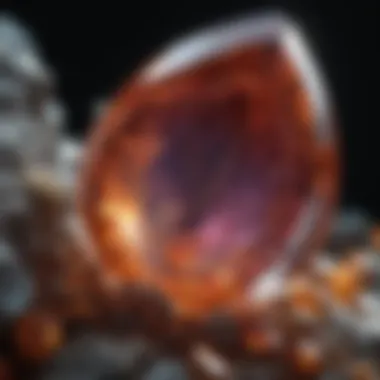Unveiling the Intricacies of Gemstone Identification: A Detailed Exploration


Rock and Fossil Identification
Embark on a detailed exploration of gemstone rock identification, where enthusiasts and collectors unravel the mysteries of these geological treasures. Discover the diverse types of gemstones and fossils, each with unique characteristics waiting to be deciphered. Learn to identify key features that distinguish one rock or fossil from another with precision and expertise. Equip yourself with essential tools for rock and fossil identification, enhancing your skill in recognizing and categorizing these precious earthly creations.
Collecting Tips and Techniques
Delve into the best practices for collecting gemstones and fossils, optimizing your experience as a collector. Uncover the secrets to locating prime collecting sites brimming with undiscovered geological treasures. Master the art of safely extracting specimens, preserving their integrity and beauty for future generations to admire. Learn invaluable techniques to enhance your collection and elevate your expertise in the world of gemstone rock identification.
Preservation and Display
Explore the realm of preservation for rocks and fossils, ensuring their longevity and pristine condition over time. Discover the meticulous techniques for preserving these geological wonders, safeguarding their intricate details and beauty for years to come. Uncover proper storage methods that maintain the quality and authenticity of your collection, embracing effective ways to showcase your gems in creative and captivating displays. Elevate your appreciation for these natural marvels through thoughtful preservation and innovative exhibition.
Geological Insights
Delight in unlocking the geological insights behind gemstone rock identification, unveiling the fascinating formations and processes that shape these natural creations. Dive into the historical significance of rocks and fossils, tracing their origin and influence throughout time. Immerse yourself in notable discoveries in the field, marveling at the profound impact of geological findings on scientific knowledge and exploration. Embrace the rich tapestry of geological wonders, immersing yourself in a world of discovery and revelation.
Introduction
Gemstone rock identification is a captivating field that offers enthusiasts and collectors a window into the intricate world of precious stones. This article serves as a comprehensive guide, delving into the complexities of gemstone identification and unraveling the mysteries behind these geological treasures. By exploring key concepts and techniques, readers will gain a profound understanding of how to differentiate and analyze various gemstones, making this journey both educational and enlightening.
Understanding Gemstone Rock Identification
The Significance of Gemstone Identification
The significance of gemstone identification lies in its pivotal role in distinguishing one gemstone from another based on unique characteristics. By understanding the distinctive properties of each stone, gemologists and collectors can discern genuine gems from imitations, facilitating informed decision-making and enhancing the value of their collections. This aspect of gemstone identification is crucial in ensuring authenticity and preventing fraud in the gemstone market. Readers will appreciate the depth of knowledge provided regarding the significance of gemstone identification, empowering them to make informed choices.
Role of Geology in Gemstone Classification
The role of geology in gemstone classification is fundamental to understanding the formation and composition of gemstones. Geology provides valuable insights into the geological processes that create gemstones, shedding light on their unique characteristics and internal structures. This section explores how geological factors influence the classification of gemstones based on their origin, mineral composition, and geological formations. By elucidating the significance of geology in gemstone classification, readers will gain a deeper appreciation for the geological forces that shape these precious stones.
Tools and Techniques
Microscopy in Gemstone Analysis
Microscopy plays a crucial role in gemstone analysis by enabling the magnified examination of a gemstone's physical features. This technique allows gemologists to identify inclusions, growth patterns, and other unique characteristics that may affect the stone's value and authenticity. Readers will discover how microscopy enhances the precision and accuracy of gemstone assessments, providing valuable insights into the hidden world within each gemstone.
Spectroscopy for Gemstone Identification
Spectroscopy is a powerful tool used in gemstone identification to analyze the interaction of gemstones with light. By examining the unique spectral signatures of gemstones, spectroscopy can reveal valuable information about their composition and identify any treatments or enhancements they may have undergone. Through the detailed exploration of spectroscopy for gemstone identification, readers will uncover the science behind this innovative technique and its significance in distinguishing between different gemstone varieties.


Chemical Analysis Methods
Chemical analysis methods offer a comprehensive approach to identifying gemstones based on their elemental composition. By utilizing techniques such as X-ray fluorescence and mass spectrometry, gemologists can determine the chemical makeup of a gemstone with precision. This section delves into the benefits and limitations of chemical analysis methods in gemstone identification, highlighting their importance in verifying gemstone authenticity and enhancing the overall understanding of gemstone compositions.
Key Characteristics
Color and Luster
Impact of Color on Gemstone Classification
Color, being one of the most prominent features of a gemstone, significantly influences its classification and overall appeal. The distinct coloration of a gemstone can indicate its origin, rarity, and even specific gem family. Understanding the impact of color on gemstone classification is crucial for identifying valuable gemstones and distinguishing them from their counterparts. The color spectrum of gemstones is vast and diverse, each hue holding its own significance within the world of gemology. Whether it's the rich blues of sapphires or the vibrant reds of rubies, color serves as a key characteristic that helps gemologists and collectors in their identification pursuits.
Luster as an Indicator of Gem Quality
Luster refers to the way light interacts with the surface of a gemstone and plays a vital role in determining its quality. The luster of a gemstone can range from dull to vitreous, and this characteristic sheds light on the gem's transparency and clarity. Gems with a highly reflective luster are often associated with superior quality and value. Understanding the luster of gemstones is essential for evaluating their overall brilliance and allure. By examining the luster of a gemstone, collectors can assess its visual appeal and authenticity, making it a crucial indicator of gem quality in the realm of gemstone identification.
Hardness and Cleavage
Mohs Scale of Hardness
The Mohs Scale of Hardness is a fundamental tool in gemstone identification, providing a standardized method for categorizing a gemstone's resistance to scratching. This scale ranges from talc, the softest mineral, to diamond, the hardest natural substance known. Understanding the Mohs scale allows collectors to determine the durability and wearability of gemstones, aiding in their proper care and maintenance. By considering a gemstone's placement on the Mohs scale, enthusiasts can make informed decisions about how to handle, store, and display their precious stones.
Cleavage Patterns in Gemstones
Cleavage patterns in gemstones refer to the way a gemstone breaks when subjected to external force. Different gemstones exhibit varying cleavage properties, with some gems cleaving neatly into distinct planes while others fracture irregularly. Recognizing and analyzing cleavage patterns in gemstones is crucial for both identification and preservation purposes. By understanding a gemstone's cleavage behavior, collectors can prevent accidental damage and ensure the longevity of their prized possessions. Cleavage patterns offer valuable insights into a gemstone's structural integrity and can influence decisions regarding cutting and setting techniques.
Specific Gravity and Refractive Index
Determining Specific Gravity
Specific gravity is a key characteristic used in gemstone identification to measure the density of a gemstone relative to water. This property aids in distinguishing between different gem materials based on their mass per unit volume. Determining the specific gravity of a gemstone allows collectors to verify its authenticity and make accurate comparisons with known gemstone data. By considering specific gravity, enthusiasts can assess the purity and composition of gemstones, leading to a better understanding of their rarity and value.
Measuring Refractive Index for Identification
Measuring the refractive index of a gemstone is essential for determining how light travels through the stone and how it interacts with facets. The refractive index provides valuable information about a gemstone's optical properties, including its brilliance and fire. By quantifying the refractive index, gemologists can identify and distinguish gemstones based on their unique light-handling capabilities. Measuring this characteristic aids in gemstone classification and helps collectors appreciate the intricacies of a gem's visual presentation. Understanding the refractive index enhances the overall assessment of a gemstone's beauty and value.
Gemstone Families
Gemstone families play a crucial role in the field of gemstone rock identification, serving as the foundational categorization for these precious stones. Understanding gemstone families is essential for enthusiasts and collectors as it provides insights into the unique characteristics, compositions, and origins of different gemstones. By delving into the various families such as diamonds, emeralds, sapphires, and rubies, individuals can appreciate the diversity and complexity of gemstone formations, enabling them to distinguish between various types based on their distinct properties. This section will explore the significance of gemstone families in offering a comprehensive framework for identifying and categorizing gemstones, shedding light on specific elements, benefits, and considerations that define each family's place in the mesmerizing world of gemstone rock identification.


Diamonds
Unique Characteristics of Diamonds
Diamonds are renowned for their exceptional hardness, brilliance, and unparalleled durability. These unique characteristics make diamonds one of the most sought-after gems in the world, prized for their rarity and mesmerizing beauty. The key characteristic of diamonds lies in their ability to refract light, creating a dazzling display of colors known as fire and brilliance. This feature not only enhances their aesthetics but also adds to their value and desirability. Despite their exceptional qualities, diamonds may have certain inclusions or flaws that can affect their clarity and overall appearance, factors that are carefully assessed in gemstone identification processes.
Popular Diamond Cuts
The cut of a diamond plays a vital role in maximizing its brilliance and visual appeal. Popular diamond cuts such as the round brilliant, princess, emerald, and marquise cuts showcase the gem's optical properties and enhance its sparkle. Each cut has unique characteristics that contribute to the overall beauty of the diamond, dictating how light interacts with the gemstone to create a stunning display of scintillation and sparkle. Choosing the right cut is crucial for showcasing the diamond's best qualities while ensuring optimal light reflection and beauty, making it a key consideration in gemstone identification and evaluation.
Emeralds
Origin and Formation of Emeralds
The origin and formation of emeralds trace back to the intricate geological processes that create these captivating gemstones. Emeralds are typically formed in metamorphic environments where intense heat and pressure interact with minerals such as beryl to produce the characteristic green hue of emeralds. This gem's unique formation gives rise to a range of inclusions, including mineral traces and fractures, which contribute to its individuality and beauty. Understanding the origin and formation of emeralds provides insights into the geological history of these gems, offering enthusiasts a deeper appreciation for their exceptional rarity and allure.
Inclusions in Emeralds
The inclusions present in emeralds are an essential aspect of their identification and valuation. These internal features, which can include crystals, liquids, or other minerals, impact the gem's clarity and overall appearance, influencing its value and desirability. Inclusions are often used to determine the authenticity and origin of emeralds, providing gemologists with valuable insights into the gem's journey from geological formation to final presentation. By examining and understanding inclusions in emeralds, collectors and enthusiasts can gain a deeper understanding of these mesmerizing gems and their unique characteristics.
Sapphires
Varieties of Sapphires
Sapphires come in a diverse range of colors and hues, known as fancy sapphires, including blue, yellow, pink, and purple variations. These different varieties of sapphires are prized for their intense colors, exceptional durability, and striking beauty, making them popular choices for jewelry and collectors alike. Each variety of sapphire possesses distinct characteristics, with some colors being rarer and more coveted than others. Exploring the varieties of sapphires allows individuals to appreciate the spectrum of colors available in these stunning gems, each presenting a unique charm and allure to the beholder.
Heat Treatment in Sapphire Enhancement
Heat treatment is a common method used to enhance the color and clarity of sapphires, improving their overall appearance and value. By subjecting sapphires to controlled heating processes, gemologists can alter the gem's internal structure, reducing or removing inclusions and improving color saturation. This enhancement technique helps unlock the full potential of sapphires, bringing out their natural beauty and optimizing their visual impact. While heat treatment can enhance a sapphire's aesthetics, it is essential to consider its impact on the gem's authenticity and transparency, ensuring transparency and disclosure in the gemstone market.
Rubies
Characteristics of Natural and Synthetic Rubies
The characteristics of natural and synthetic rubies differ in various aspects, influencing their appearance, durability, and value. Natural rubies are coveted for their vivid color, exceptional hardness, and rarity, making them prized gems for jewelry and collectors. On the other hand, synthetic rubies are created in laboratory settings to mimic the properties of natural rubies, offering an affordable alternative with similar visual appeal. Distinguishing between natural and synthetic rubies requires careful examination of their physical and optical properties, ensuring authenticity and value in gemstone identification processes.
Famous Ruby Mines
Famous ruby mines such as the Mogok Valley in Myanmar and the Montepuez mine in Mozambique have yielded some of the world's most valuable rubies, renowned for their exceptional color and quality. These iconic mining locations are associated with the discovery of rare and large rubies, captivating collectors and gem enthusiasts with their rich history and abundance of precious stones. Exploring famous ruby mines deepens our understanding of the geological processes that create these exquisite gems, highlighting the importance of location and mining practices in determining a ruby's rarity and value in the global gemstone market.


Identifying Rarity and Value
The section on Identifying Rarity and Value in this article is paramount in the realm of gemstone rock identification. Understanding the factors that contribute to the rarity and value of gemstones is crucial for enthusiasts and collectors alike. By delving into the rarity and value aspects, readers can gain a profound insight into what makes certain gemstones highly sought after and valuable in the market. This section will highlight the significance of rarity and value appraisal techniques, shedding light on the intricacies of gemstone valuation processes and the impact these aspects have on the overall appreciation and investment potential of gemstones.
Factors Influencing Gemstone Value
Rarity of Gemstones
The Rarity of Gemstones holds a pivotal role in gemstone valuation and market dynamics. Gemstones that are scarce and difficult to acquire naturally command higher prices and are often more coveted by collectors. The scarcity of a particular gemstone can be determined by various factors such as geological conditions, mining locations, and the limited availability of certain gemstone varieties. Understanding the rarity of gemstones not only adds a layer of exclusivity to one's collection but also serves as a testament to the geological uniqueness and historical significance of each gemstone. This article will delve into the unique characteristics of rare gemstones, their desirability among collectors, and the implications of rarity on gemstone pricing and market demand.
Market Trends and Demand
The fluctuating Market Trends and Demand play a substantial role in influencing the overall value of gemstones. Keeping abreast of market trends, consumer preferences, and demand patterns is essential for assessing the current and future value prospects of gemstone investments. Gemstones that align with prevailing market trends and undergo fluctuations in demand levels can experience significant variations in their market value. Analyzing market trends allows collectors to anticipate shifts in gemstone valuation, identify emerging trends in the industry, and make informed decisions regarding gemstone acquisitions and portfolio management. This article will explore the nuanced relationship between market trends, consumer demand, and gemstone valuation, providing insights into the dynamic nature of the gemstone market and the factors that drive value fluctuations.
Certification and Appraisal
Role of Gemological Institutes
The Role of Gemological Institutes serves as a cornerstone in the gemstone industry, offering expert guidance and standardization in gemstone certification and valuation practices. Gemological institutes play a vital role in verifying the authenticity, quality, and characteristics of gemstones through rigorous testing and examination protocols. Their involvement ensures transparency and reliability in gemstone transactions, instilling trust among buyers and collectors. This article will elucidate the pivotal role that gemological institutes play in gemstone identification, certification processes, and the overarching significance of relying on accredited institutions for gemstone appraisal and authentication.
Appraisal Methods for Gemstones
Appraisal Methods for Gemstones encompass a diverse range of techniques used to evaluate the quality, value, and attributes of gemstones accurately. From assessing color saturation and clarity to measuring carat weight and dimensions, appraisal methods involve detailed examination and analysis to determine the market worth of gemstones. Different appraisal methodologies exist for various gemstone types, each tailored to highlight the unique characteristics and value indicators specific to different gemstone varieties. This article will delve into the intricacies of gemstone appraisal methods, detailing the appraisal process, key valuation factors, and the importance of accurate appraisal in determining the value and authenticity of gemstones.
Ethical Concerns and Sustainability
In the realm of gemstone rock identification, ethical concerns and sustainability play a crucial role that cannot be overlooked. This section sheds light on the ethical considerations and sustainable practices that are integral to the gemstone industry. By addressing these issues, collectors and enthusiasts gain a deeper understanding of the impact of their hobby on the environment and society.
Ethical Mining Practices
Fair Trade Gemstones
Fair trade gemstones have emerged as a beacon of ethical sourcing in the gemstone industry. They ensure that miners and workers in developing countries receive fair compensation for their labor while adhering to stringent social and environmental standards. The key characteristic of fair trade gemstones lies in their transparency and traceability, providing consumers with peace of mind regarding the origins of their precious stones. This ethical choice promotes sustainable development in mining communities and aligns with the overarching goals of this article in promoting responsible gemstone practices.
Conflict-Free Sourcing
Conflict-free sourcing addresses the ethical dilemma of gemstones mined in regions plagued by violence or exploitation. By opting for conflict-free stones, collectors contribute to peace-building efforts and mitigate the negative impacts of war-torn mining areas. The key characteristic of conflict-free sourcing is the assurance that the gemstones have not fueled armed conflict or human rights abuses. This ethical sourcing approach resonates with the core themes of this article, emphasizing the importance of ethical considerations in gemstone acquisition.
Environmental Impact
Conservation Efforts in Gemstone Mining
Conservation efforts in gemstone mining underline the necessity of preserving natural habitats and ecosystems affected by mining activities. By implementing sustainable mining practices and rehabilitating mined-out areas, the industry minimizes its environmental footprint and fosters biodiversity conservation. The key characteristic of conservation efforts lies in their proactive approach to environmental stewardship, balancing the extraction of natural resources with long-term ecological sustainability. This focus on environmental responsibility aligns with the ethos of this article, championing the importance of mitigating environmental harm in gemstone procurement.
Eco-Friendly Practices
Eco-friendly practices represent a pivotal shift towards sustainable mining operations that prioritize resource efficiency and pollution prevention. From utilizing renewable energy sources to implementing recycling programs, eco-friendly practices reduce the overall ecological impact of gemstone extraction and processing. The key characteristic of eco-friendly practices is their commitment to mitigating greenhouse gas emissions and habitat destruction, promoting a greener and more sustainable future for the gemstone industry. Embracing these practices aligns harmoniously with the overarching message of this article, advocating for a more environmentally conscious approach to gemstone exploration and collection.







